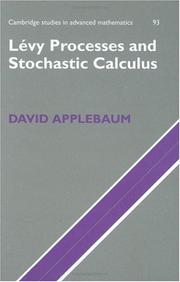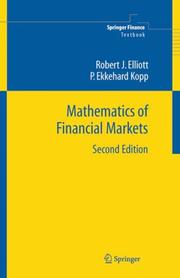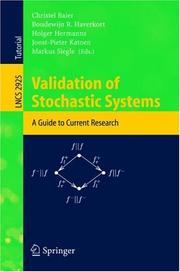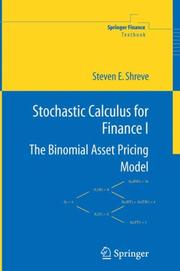| Listing 1 - 5 of 5 |
Sort by
|

ISBN: 1281876968 9786611876968 9812565388 9812380957 9789812380951 9789812565389 9781281876966 Year: 2004 Publisher: Singapore ; London : World Scientific,
Abstract | Keywords | Export | Availability | Bookmark
 Loading...
Loading...Choose an application
- Reference Manager
- EndNote
- RefWorks (Direct export to RefWorks)
A random field is a mathematical model of evolutional fluctuatingcomplex systems parametrized by a multi-dimensional manifold like acurve or a surface. As the parameter varies, the random field carriesmuch information and hence it has complex stochastic structure.The authors of this book use an approach that is characteristic:namely, they first construct innovation, which is the most elementalstochastic process with a basic and simple way of dependence, and thenexpress the given field as a function of the innovation. Theytherefore establish an infinite-dimensional stochastic calculus, inpartic
Stochastic analysis. --- Random fields. --- Fields, Random --- Stochastic processes --- Analysis, Stochastic --- Mathematical analysis

ISBN: 0521832632 0511211198 9780511211195 9780521832632 0511216564 9780511216565 0511212968 9780511212963 0511214774 9780511214776 9780511755323 0511755325 1107148871 1280540400 9786610540402 0511315341 Year: 2004 Publisher: Cambridge : Cambridge University Press,
Abstract | Keywords | Export | Availability | Bookmark
 Loading...
Loading...Choose an application
- Reference Manager
- EndNote
- RefWorks (Direct export to RefWorks)
Lévy processes form a wide and rich class of random process, and have many applications ranging from physics to finance. Stochastic calculus is the mathematics of systems interacting with random noise. For the first time in a book, Applebaum ties the two subjects together. He begins with an introduction to the general theory of Lévy processes. The second part develops the stochastic calculus for Lévy processes in a direct and accessible way. En route, the reader is introduced to important concepts in modern probability theory, such as martingales, semimartingales, Markov and Feller processes, semigroups and generators, and the theory of Dirichlet forms. There is a careful development of stochastic integrals and stochastic differential equations driven by Lévy processes. The book introduces all the tools that are needed for the stochastic approach to option pricing, including Itô's formula, Girsanov's theorem and the martingale representation theorem.
Stochastic processes --- Lévy processes --- Stochastic analysis --- 519.22 --- Analysis, Stochastic --- Mathematical analysis --- Random walks (Mathematics) --- Lévy processes. --- Stochastic analysis. --- Lévy processes.

ISBN: 9780387226408 0387226400 9780387212920 0387212922 Year: 2004 Publisher: New York Springer
Abstract | Keywords | Export | Availability | Bookmark
 Loading...
Loading...Choose an application
- Reference Manager
- EndNote
- RefWorks (Direct export to RefWorks)
This book presents the mathematics that underpins pricing models for derivative securities, such as options, futures and swaps, in modern financial markets. The idealized continuous-time models built upon the famous Black-Scholes theory require sophisticated mathematical tools drawn from modern stochastic calculus. However, many of the underlying ideas can be explained more simply within a discrete-time framework. This is developed extensively in this substantially revised second edition to motivate the technically more demanding continuous-time theory, which includes a detailed analysis of the Black-Scholes model and its generalizations, American put options, term structure models and consumption-investment problems. The mathematics of martingales and stochastic calculus is developed where it is needed. The new edition adds substantial material from current areas of active research, notably: a new chapter on coherent risk measures, with applications to hedging a complete proof of the first fundamental theorem of asset pricing for general discrete market models the arbitrage interval for incomplete discrete-time markets characterization of complete discrete-time markets, using extended models risk and return and sensitivity analysis for the Black-Scholes model The treatment remains careful and detailed rather than comprehensive, with a clear focus on options. From here the reader can progress to the current research literature and the use of similar methods for more exotic financial instruments. The text should prove useful to graduates with a sound mathematical background, ideally a knowledge of elementary concepts from measure-theoretic probability, who wish to understand the mathematical models on which the bewildering multitude of current financial instruments used in derivative markets and credit institutions is based. The first edition has been used successfully in a wide range of Master's programs in mathematical finance and this new edition should prove even more popular in this expanding market. It should equally be useful to risk managers and practitioners looking to master the mathematical tools needed for modern pricing and hedging techniques. Robert J. Elliott is RBC Financial Group Professor of Finance at the Haskayne School of Business at the University of Calgary, having held positions in mathematics at the University of Alberta, Hull, Oxford, Warwick, and Northwestern. He is the author of over 300 research papers and several books, including Stochastic Calculus and Applications, Hidden Markov Models (with Lahkdar Aggoun and John Moore) and, with Lakhdar Aggoun, Measure Theory and Filtering: Theory and Applications. He is an Associate Editor of Mathematical Finance, Stochastics and Stochastics Reports, Stochastic Analysis and Applications and the Canadian Applied Mathematics Quarterly. P. Ekkehard Kopp is Professor of Mathematics, and a former Pro-Vice-Chancellor, at the University of Hull. He is the author of Martingales and Stochastic Integrals, Analysis and, with Marek Capinski, of Measure, Integral and Probability. He is a member of the Editorial Board of Springer Finance.
Investments --- Stochastic analysis. --- Options (Finance) --- Securities --- Mathematics. --- Mathematical models. --- Prices --- Stochastic analysis --- 305.91 --- AA / International- internationaal --- Analysis, Stochastic --- Mathematical analysis --- Stochastic processes --- Blue sky laws --- Capitalization (Finance) --- Investment securities --- Portfolio --- Scrip --- Securities law --- Underwriting --- Investment banking --- Mathematics of investment --- Business mathematics --- Mathematics --- Mathematical models --- Prices&delete& --- Econometrie van de financiële activa. Portfolio allocation en management. CAPM. Bubbles --- Law and legislation --- Money market. Capital market --- International finance --- Mathematical statistics

ISSN: 03029743 ISBN: 3540222650 9783540222651 9786610307876 1280307870 3540246118 Year: 2004 Volume: 2925 Publisher: Berlin, Heidelberg : Springer Berlin Heidelberg : Imprint: Springer,
Abstract | Keywords | Export | Availability | Bookmark
 Loading...
Loading...Choose an application
- Reference Manager
- EndNote
- RefWorks (Direct export to RefWorks)
Stochastic analysis --- Stochastic processes --- Computation by Abstract Devices. --- Processor Architectures. --- Mathematics. --- Microprocessors. --- Software engineering. --- Operating systems (Computers). --- Computers. --- Computer logic. --- Probabilities. --- Probability Theory and Stochastic Processes. --- Logics and Meanings of Programs. --- Software Engineering. --- Operating Systems. --- Stochastic systems. --- Stochastic analysis. --- Stochastic processes. --- Random processes --- Probabilities --- Analysis, Stochastic --- Mathematical analysis --- Systems, Stochastic --- System analysis --- Distribution (Probability theory. --- Computer science. --- Logic design. --- Computer operating systems --- Computers --- Disk operating systems --- Systems software --- Computer software engineering --- Engineering --- Design, Logic --- Design of logic systems --- Digital electronics --- Electronic circuit design --- Logic circuits --- Machine theory --- Switching theory --- Informatics --- Science --- Distribution functions --- Frequency distribution --- Characteristic functions --- Operating systems --- Minicomputers --- Computer science logic --- Logic, Symbolic and mathematical --- Automatic computers --- Automatic data processors --- Computer hardware --- Computing machines (Computers) --- Electronic brains --- Electronic calculating-machines --- Electronic computers --- Hardware, Computer --- Computer systems --- Cybernetics --- Calculators --- Cyberspace --- Probability --- Statistical inference --- Combinations --- Mathematics --- Chance --- Least squares --- Mathematical statistics --- Risk

ISBN: 9780387249681 0387249680 0387401016 9780387401003 9781441923110 9780387401010 0387401008 0387225277 144192311X Year: 2004 Publisher: New York, ... : Springer,
Abstract | Keywords | Export | Availability | Bookmark
 Loading...
Loading...Choose an application
- Reference Manager
- EndNote
- RefWorks (Direct export to RefWorks)
Stochastic Calculus for Finance evolved from the first ten years of the Carnegie Mellon Professional Master's program in Computational Finance. The content of this book has been used successfully with students whose mathematics background consists of calculus and calculus-based probability. The text gives both precise statements of results, plausibility arguments, and even some proofs, but more importantly intuitive explanations developed and refine through classroom experience with this material are provided. The book includes a self-contained treatment of the probability theory needed for stchastic calculus, including Brownian motion and its properties. Advanced topics include foreign exchange models, forward measures, and jump-diffusion processes. This book is being published in two volumes. The first volume presents the binomial asset-pricing model primarily as a vehicle for introducing in the simple setting the concepts needed for the continuous-time theory in the second volume. Chapter summaries and detailed illustrations are included. Classroom tested exercises conclude every chapter. Some of these extend the theory and others are drawn from practical problems in quantitative finance. Advanced undergraduates and Masters level students in mathematical finance and financial engineering will find this book useful. Steven E. Shreve is Co-Founder of the Carnegie Mellon MS Program in Computational Finance and winner of the Carnegie Mellon Doherty Prize for sustained contributions to education.
-332.0151922 --- 519.86 --- 336.7 --- AA / International- internationaal --- 305.970 --- 305.91 --- 305.7 --- 336.7 Geldwezen. Kredietwezen. Bankwezen. Financien. Monetaire econonomie. Beurswezen --- Geldwezen. Kredietwezen. Bankwezen. Financien. Monetaire econonomie. Beurswezen --- 519.86 Theory of economic-mathematical models --- Theory of economic-mathematical models --- Algemeenheden: Autoregression and moving average representation. ARIMA. ARMAX. Lagrange multiplier. Wald. Function (mis) specification. Autocorrelation. Homoscedasticity. Heteroscedasticity. ARCH. GARCH. Integration and co-integration. Unit roots. --- Econometrie van de financiële activa. Portfolio allocation en management. CAPM. Bubbles. --- Econometrie van het gedrag van de financiële tussenpersonen. Monetaire econometrische modellen. Monetaire agregaten. vraag voor geld. Krediet. Rente. --- Stochastic processes --- Finance --- Stochastic analysis --- Analysis, Stochastic --- Mathematical analysis --- Funding --- Funds --- Economics --- Currency question --- Mathematical models --- Econometrie van het gedrag van de financiële tussenpersonen. Monetaire econometrische modellen. Monetaire agregaten. vraag voor geld. Krediet. Rente --- Econometrie van de financiële activa. Portfolio allocation en management. CAPM. Bubbles --- Algemeenheden: Autoregression and moving average representation. ARIMA. ARMAX. Lagrange multiplier. Wald. Function (mis) specification. Autocorrelation. Homoscedasticity. Heteroscedasticity. ARCH. GARCH. Integration and co-integration. Unit roots --- Finances --- Analyse stochastique --- Textbooks --- Modèles mathématiques --- Manuels --- Textbooks. --- Economics, Mathematical . --- Applied mathematics. --- Engineering mathematics. --- Finance. --- Probabilities. --- Quantitative Finance. --- Applications of Mathematics. --- Finance, general. --- Probability Theory and Stochastic Processes. --- Probability --- Statistical inference --- Combinations --- Mathematics --- Chance --- Least squares --- Mathematical statistics --- Risk --- Engineering --- Engineering analysis --- Mathematical economics --- Econometrics --- Methodology --- Finance - Mathematical models - Textbooks --- Stochastic analysis - Textbooks --- Mathématique appliquée --- Probabilités --- Théorie financière
| Listing 1 - 5 of 5 |
Sort by
|

 Search
Search Feedback
Feedback About
About Help
Help News
News